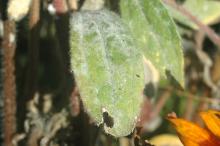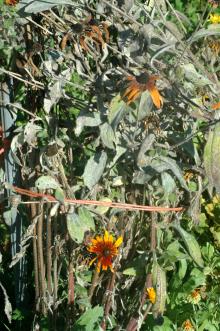Cause Golovinomyces cichoracearum (formerly Erysiphe cichoracearum) has been reported from Idaho and it is a common garden problem in Oregon. The fungus is favored by conditions that produce high humidity but dry leaves. They are highly specialized pathogens that form a close association with the host. Conditions that favor the host also favor the pathogen. Much of the fungus remains outside infected plant parts where it grows on the surface but sinks root-like structures called haustoria into plant cells to obtain nutrients. The white growth is composed of both mycelium and fungal spores.
Symptoms Grayish-white, powdery spots develop on both sides of leaves. Some yellowing and premature defoliation may be observed. Leaves may be completely coated white by late summer.
Cultural control
- Space plants for good air circulation.
- Avoid high nitrogen fertilizers.
Chemical control Fungicides will do best when used before symptoms develop. Few materials have good eradicant activity. Use at 7- to 14-day intervals; using shorter intervals when environmental conditions favor disease development. Alternate or tank-mix products from different groups that have different modes of action. Limit the use of any one group during crop production.
- Heritage at 1 to 4 oz/100 gal water plus a non-silicone-based wetter sticker may be effective before symptoms develop. Group 11 fungicide. 4-hr reentry.
- Insignia SC at 3 to 6 fl oz/100 gal water. Do not use with organosilicate-based adjuvants. Use preventively only. Group 11 fungicide. 12-hr reentry.
- Orkestra at 6 to 8 fl oz/100 gal water. Group 7 + 11 fungicide. 12-hr reentry.
- Ortho Rose & Flower Disease Control at 2 fl oz/gal water. Group 3 fungicide. H
- Pageant at 6 to 12 oz/100 gal water. Do not use with organosilicone-based adjuvants. Group 7 + 11 fungicide. 12-hr reentry.
- Phyton 27 at 1.5 to 2.5 oz/10 gal water. Group M1 fungicide. 48-hr reentry.
- Postiva at 10 to 28 fl oz/100 gal water. Group 3 + 7 fungicide. 12-hr reentry.
- Seido at 4 to 5 fl oz/100 gal water plus an adjuvant. Group 50 fungicide. 4-hr reentry.
Reference Braun, U. and Cook, R.T.A. 2012. Taxonomic Manual of the Erysiphales (Powdery Mildews). CBS-KNAW Fungal Biodiversity Center, The Netherlands.



